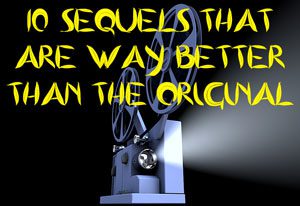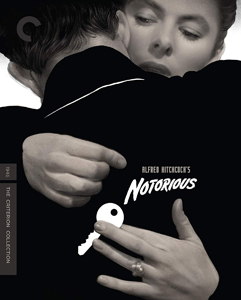“Notorious” (1946) is the entry in Alfred Hitchcock’s oeuvre that can be most crisply studied for its artistry in slow-burn suspense. Ingrid Bergman’s Alicia – working for American agents — has married Nazi operative Alex (Claude Rains) with the goal of gathering information about Germany’s plans.
Without overtly spelling out anything via dialog, Hitchcock – working from Ben Hecht’s screenplay that comes from John Taintor Foote’s 1921 short story “The Song of the Dragon” – has us on the edges of our seats. It’s an ongoing game where Ingrid knows something, we know that Alex knows, and we’re hoping American spy hero Devlin (Cary Grant) will know (and save Alicia’s life and the free world’s fortunes) before it’s too late. It has to be watched closely, and it rewards close watching.
Although Hitchcock’s film was adapted into – or at least paid homage by – the action movie “Mission: Impossible II” (2000), “Notorious” is in a different genre: spy intrigue. It’s more progressive than “M:I2” in that Alicia is the main character tasked with actively gathering information at Alex’s Rio de Janeiro mansion. In “M:I2,” Thandie Newton’s Nyah morphs from subject to object, as I’ll analyze later.

“Notorious” (1946)
Director: Alfred Hitchcock
Writers: Ben Hecht (screenplay), John Taintor Foote (short story)
Stars: Cary Grant, Ingrid Bergman, Claude Rains
A trio of POVs
Early in “Notorious,” Devlin is the hero. And, interestingly, we are allowed to sympathize with Alex in a gut-wrenching catch-22 in the grand finale. But Alicia is the one we follow through the bulk of the run time.
Of course, it helps that we’re drawn to the beautiful Bergman, who has soporific/sensual, non-scored scenes with the suave Grant. Alicia and Devlin fall in love – and the actors’ chemistry makes us believe it – even as he’s willing to send her into the wolves’ den (and she’s willing to go) for the sake of getting an edge in the post-WWII cold war. “M:I2’s” relationship/conflict between Ethan (Tom Cruise) and cat burglar Nyah copies Devlin-Alicia.
“M:I2” stops just short of the invisible line between “homage” and “theft.” But it’s obvious that the team of three writers had “Notorious” on their mind, as there are too many parallels to chalk up to coincidence.
“Notorious” wins the competition, but director John Woo’s “M:I2” gets a measure of victory, too. It’s rightly regarded as the weakest of the “M:I” films, but its action and overall plot are good, and if it happened to be a “Fast & Furious” film it would be much more highly regarded. It’s hampered because the “M:I” saga went on to produce increasingly envelope-pushing action films after this one.
The fact that it comes from “Notorious” gives it a certain cachet, as “M:I2” follows the axiom of “If you’re gonna steal, steal from the best.” Here are some key points of comparison and divergence (SPOILERS FOLLOW for both films):

‘Notorious’-‘Mission: Impossible II’ connections
The foreign “bad girl.”
Alicia is German-American, which passed for exotic in 1946, whereas Nyah’s background is unstated, but actress Newton is Zimbabwean-British. Both Alicia and Nyah formerly dated the villain of the piece, who is still smitten with the lady, paving the path for infiltration.
Whereas Alicia becomes the focal character, Nyah gradually fades from the spotlight. A case could be made that Newton gives one of the best performances ever in service of a screenplay that’s uninterested in her character. Nyah becomes a human maguffin when she injects herself with a virus at about mid-film.
Alicia’s sickness – via slow poisoning (perhaps by arsenic?) that was a mystery-genre trope at this time – also plays into “Notorious’ ” final act.
The fate of the world.
“M:I2” awkwardly overexplains Chimera/Bellerophon, the virus and cure that will net the villain billions if he can get both into the marketplace. “Notorious” underexplains the sand in a wine bottle, which is why this film is such a great teaching tool in the art of suspense. Hitchcock took the position that maguffins (objects that matter because the visual cues tell us they matter) are valid stand-ins for thoroughly explained items.
Hitchcock doesn’t bother with stating that the sand is the ingredient for a super-bomb. The way people react to the stuff is enough. First, poor Nazi underling Emil is uncomfortable when the bottle is positioned next to true wine bottles. His cohorts decide Emil is too frazzled to be trusted, and they execute him off screen.
Hitchcock’s zoom-in emphasis on the keys to the wine cellar (where this bottle of sand is located, to perhaps be found by their enemies) further shows that this maguffin matters. Hitchcock’s focus on the keys (temporarily stolen from Alex by Alicia) likewise builds tension toward Alex figuring out his wife is a spy.
Specific sequences.
“Notorious” is not an action movie, and after you view the one action sequence – Alicia drunken-driving on Miami roads while Devlin gets ready to grab the wheel from her – you’ll be glad it’s not. (“Foreign Correspondent” is closer to an action movie, if you want to see how Hitch handles that genre.) “M:I2” likewise front-loads a wild driving sequence, this time with Ethan and Nyah in different cars.
In both cases, these sequences show the push-pull between the male and female leads. They are enemies of a sort – Nyah is a thief, Alicia is the daughter of a convicted German spy — but also have a literally dangerous romantic attraction.
The most one-to-one sequences are at the race track. Alicia and Devlin, and Nyah and Ethan, hold serious conversations while pretending not to, because they know they might be (and we know they are) watched by villains Alex and Sean (Dougray Scott) via binoculars.
Action vs. intrigue
As the films proceed, “M:I2” branches into full-on action but becomes less compelling, as Nyah has become a human maguffin that must be reacquired. Ethan doesn’t even interact with her after she turns herself into the Chimera carrier, until the happy ending. (Cruise does interact with Newton, because Sean wears an Ethan latex mask in “Mission: Impossible” fashion in order to confirm that Nyah is a spy. But technically that is not Ethan.)
Hitchcock, on the other hand, keeps his leads interacting throughout the film. Devlin and Alicia meet on Rio benches to exchange notes. Then Devlin enters Alex’s compound for the tense grand finale.
“M:I2” is all about the action – to its detriment – as it moves toward its finish line. Viewers have basic plot facts and end-of-the-world stakes to think of, but nothing with layers of intrigue. We’re not gripped by an ever-evolving story; it’s just a matter of “Will the good guy win?” (And of course there’s only one possible answer to that.)
“Notorious” is all about the intrigue, as we mull the delicate chess moves by Devlin, Alicia and Alex – even to the point where we almost sympathize with Alex because his situation is so complex.
“Notorious” is the more engaging film thanks to Hitchcock’s mastery of cinematic storytelling, whereas “Mission: Impossible II” has to settle for having better explosions and games of motorcycle chicken. Say this much for it, though: It picks a good film to borrow from. That makes “M:I2” better than it otherwise would’ve been, and also helps keep both films alive today as cinema worth discussing.
RFMC’s Alfred Hitchcock series reviews works by the Master of Suspense, plus remakes and source material. Click here to visit our Hitchcock Zone.

